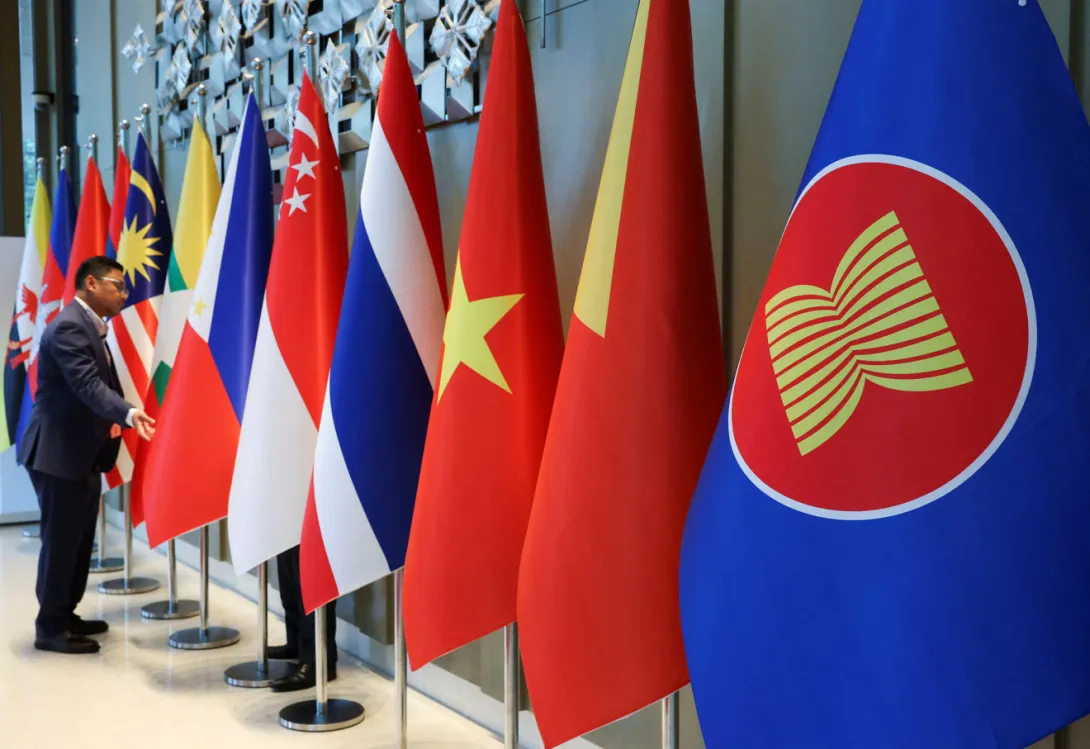
ASEAN must enhance regional integration Image: REUTERS/Hasnoor Hussain
This article is part of:Annual Meeting of the New Champions
- The Association of Southeast Asian Nations (ASEAN) must accelerate investment in digital infrastructure, advanced manufacturing and energy transition technologies.
- Countries such as Viet Nam, Thailand and Malaysia are shifting from traditional economic roles to higher-value industries.
- This article was first published in The Jakarta Post, read it here.
Global trade tensions, policy uncertainty and subdued foreign direct investment pose a challenging economic environment for emerging markets as efforts to stimulate growth, create jobs and cut poverty are all held back.
This has led to downgrades to growth forecasts across emerging economies – and the Association of Southeast Asian Nations (ASEAN) is no exception.
Countries across the region, from Thailand and Vietnam to Indonesia to Malaysia, are feeling the pinch. In the face of these headwinds, ASEAN’s resilience depends on investing in innovation, digital transformation and advanced manufacturing, as well as deepening regional cooperation.
Investing in technology
Faced with this complex scenario, ASEAN economies must build up their resilience. At the heart of the strategy for achieving this is a concerted drive to invest in technology. This will put the region in a far stronger position to embrace the digital and energy transitions and strengthen advanced manufacturing.
Already, ASEAN has taken great strides to boost its technological capacity. Among the most significant is the ongoing negotiation of the game-changing Digital Economy Framework Agreement (DEFA).
Have you read?
- Why ASEAN’s new Digital Economy Framework Agreement is a game-changer
- Will ASEAN be the world’s most attractive region in 2025? Here's what leaders said at Davos
- How data standards, ethical AI and diaspora are key to ASEAN's digital economy
Planned to be concluded in 2025 under Malaysia’s ASEAN chairmanship, it will be a strategic roadmap for seizing opportunities offered by the digital transition.
The world’s first region-wide digital economy agreement, DEFA’s goal is to harmonize digital trade rules and unlock the potential of ASEAN’s digital economy, which is set to double to $2 trillion by 2030.
The Malaysian government has also led the charge in participating in the Centre for the Fourth Industrial Revolution (C4IR) network, a World Economic Forum initiative that connects technology policy experts and stakeholders across the globe to scale up projects and initiatives through independent centres.
Launched in 2023, Malaysia’s Centre for the Fourth Industrial Revolution (C4IR) became ASEAN’s first; Viet Nam followed suit shortly afterwards in 2024 with a C4IR in the Saigon Hi-Tech Park that aims to advance technological development both nationally and across the region.
From a fast follower strategy to climbing the semiconductor value chain
Adding to this momentum, Viet Nam’s government has unveiled two highly ambitious initiatives in recent months.
One, Resolution 57, is aimed at supporting science, technology and digital innovation through a comprehensive programme that includes streamlining regulation, investing in infrastructure and nurturing talent.
The other, Resolution 68, is a milestone directive that envisages a globally competitive private sector by promoting the growth of 20 large companies by 2030.
Meanwhile, Thailand, which produces about 15% of global rice exports, is attempting to elevate its position in the global food market by transitioning away from being a primary rice producer to become a leader in agro-processing.
In doing so, Thailand can strategically move up the agriculture value chain, strengthen economic benefits for farmers, and promote sustainable and resilient agricultural practices.
In one flagship project in the heart of Thailand’s rice bowl, local communities are working to alleviate the impact of increasingly extreme climate conditions through flood control and sustainable water management.
Have you read?
ASEAN as a whole is positioning itself as a global manufacturing hub, targeting areas where China is at a disadvantage due to recent trade tensions. The semiconductor industry is of particular interest, with ASEAN’s participation currently limited to the lower end of the value chain in the form of assembly-testing-packaging operations.
As artifcal intelligence advances, ASEAN has a clear opportunity to move up the value chain, with member states offering incentives to attract higher-value semiconductor investment.
The importance of regional cooperation
The true potential of ASEAN can only be fully unlocked if countries work together. This will yield multiple benefits – whether as a larger integrated market, attracting more foreign direct investment, standing up to global shocks, better digital integration or greater supply chain resilience.
The region knows this: it reaffirmed its commitment to building a “resilient, innovative, dynamic, people-centred ASEAN” by adopting the ASEAN Community Vision 2045 in May. Singapore has taken a step further through its strong commitment to a rules-based international trading system that will benefit ASEAN as a whole.
Closer cooperation will also enable the region to leverage its diversity more effectively. A key regional initiative, the ASEAN Power Grid (APG), is already utilizing renewable energy resources across ASEAN.

By facilitating exports from countries such as Laos that have a surplus of green energy to high-demand centres like Singapore, the APG takes advantage of a larger, more integrated grid to balance power supply and support cross-border electricity trade.
Further collaboration is essential, especially given that while Indonesia, ASEAN’s largest economy, is a major commodity exporter, most countries, including Thailand, Viet Nam and Malaysia, are commodity importers.
Certainly, it will be important to properly harness the power and influence of Indonesia, ASEAN’s only G20 country – not least given its wealth of critical minerals, especially nickel, a vital ingredient for lithium-ion batteries.
A key opportunity for cooperation both within and beyond the region is presented by the World Economic Forum’s 16th Annual Meeting of the New Champions 2025, held 24-26 June in Tianjin, China.
Ultimately, governments must lead the drive to bring the region closer together but that is not enough. The most effective collaboration requires the engagement of the private sector, civil society and international organizations as well.